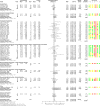Limited evidence of physical therapy on balance after stroke: A systematic review and meta-analysis
- PMID: 31465462
- PMCID: PMC6715189
- DOI: 10.1371/journal.pone.0221700
Limited evidence of physical therapy on balance after stroke: A systematic review and meta-analysis
Abstract
Background: Stroke results in balance disorders and these directly affect autonomy and quality of life. The purpose of this systematic review and meta-analysis was to determine the efficacy of physical therapy (PT) on balance and postural control after stroke.
Methods: We included all randomized controlled trials assessing the efficacy of PT on balance and postural control in adult patients after stroke without language restriction. Medline, Embase/Scopus, Cochrane Central Register of Controlled Trials, PEDro, Pascal, and Francis databases were searched until January 2019. Primary outcomes were balance (Berg Balance scale and Postural Assessment Scale for Stroke) and postural control with postural deviation or stability measurement in sitting or standing static evaluation. A pair of independent reviewers selected studies, extracted data, and assessed risk of bias. Meta-analyses with subgroups (categories of PT, time post-stroke, and lesion location) and meta-regression (duration of PT) were conducted.
Results: A total of 145 studies (n = 5912) were selected from the 13,123 records identified. For balance, evidence was found in favor of the efficacy of functional task-training alone (standardized mean difference 0.39, 95% confidence interval [0.09; 0.68], heterogeneity I2 = 63%) or associated with musculoskeletal intervention and/or cardiopulmonary intervention (0.37, [0.19; 0.55], I2 = 48%), electrostimulation (0.91, [0.49; 1.34], I2 = 52%) immediately after intervention, compared to sham treatment or usual care (ST/UC). For postural deviation eyes open, assistive devices were more effective than no treatment (-0.21, [-0.37; -0.05], I2 = 0%) immediately after intervention; for postural stability eyes open, functional task-training and sensory interventions were more effective than ST/UC (0.97, [0.35; 1.59], I2 = 65% and 0.80, [0.46; 1.13], I2 = 37% respectively) immediately after intervention.
Conclusions: Functional task-training associated with musculoskeletal intervention and/or cardiopulmonary intervention and sensory interventions seem to be immediately effective in improving balance and postural stability, respectively. The heterogeneity of PT and the weak methodological quality of studies limited the interpretation and the confidence in findings.
Conflict of interest statement
The authors have declared that no competing interests exist.
Figures








Similar articles
-
Publication language and the estimate of treatment effects of physical therapy on balance and postural control after stroke in meta-analyses of randomised controlled trials.PLoS One. 2020 Mar 9;15(3):e0229822. doi: 10.1371/journal.pone.0229822. eCollection 2020. PLoS One. 2020. PMID: 32150596 Free PMC article.
-
Folic acid supplementation and malaria susceptibility and severity among people taking antifolate antimalarial drugs in endemic areas.Cochrane Database Syst Rev. 2022 Feb 1;2(2022):CD014217. doi: 10.1002/14651858.CD014217. Cochrane Database Syst Rev. 2022. PMID: 36321557 Free PMC article.
-
Efficiency of physical therapy on postural imbalance after stroke: study protocol for a systematic review and meta-analysis.BMJ Open. 2017 Jan 30;7(1):e013348. doi: 10.1136/bmjopen-2016-013348. BMJ Open. 2017. PMID: 28137928 Free PMC article.
-
Robot-assisted therapy for balance function rehabilitation after stroke: A systematic review and meta-analysis.Int J Nurs Stud. 2019 Jul;95:7-18. doi: 10.1016/j.ijnurstu.2019.03.015. Epub 2019 Mar 28. Int J Nurs Stud. 2019. PMID: 31002951
-
The effectiveness of trunk training on trunk control, sitting and standing balance and mobility post-stroke: a systematic review and meta-analysis.Clin Rehabil. 2019 Jun;33(6):992-1002. doi: 10.1177/0269215519830159. Epub 2019 Feb 22. Clin Rehabil. 2019. PMID: 30791703
Cited by
-
The effect of balance training using touch controller-based fully immersive virtual reality devices on balance and walking ability in patients with stroke: A pilot randomized controlled trial.Medicine (Baltimore). 2024 Jul 5;103(27):e38578. doi: 10.1097/MD.0000000000038578. Medicine (Baltimore). 2024. PMID: 38968468 Free PMC article. Clinical Trial.
-
Is the Assessment of the Non-Paretic Lower Limb in Patients After Stroke Important When Planning Rehabilitation?Sensors (Basel). 2025 Feb 11;25(4):1082. doi: 10.3390/s25041082. Sensors (Basel). 2025. PMID: 40006310 Free PMC article.
-
The Application of Biological Feedback in the Rehabilitation of Patients after Ischemic Stroke.Sensors (Basel). 2022 Feb 24;22(5):1769. doi: 10.3390/s22051769. Sensors (Basel). 2022. PMID: 35270916 Free PMC article.
-
Acupuncture of fascia points to relieve hand spasm after stroke: a study protocol for a multicenter randomized controlled trial.Trials. 2020 Jan 10;21(1):69. doi: 10.1186/s13063-019-3999-7. Trials. 2020. PMID: 31924256 Free PMC article.
-
Publication language and the estimate of treatment effects of physical therapy on balance and postural control after stroke in meta-analyses of randomised controlled trials.PLoS One. 2020 Mar 9;15(3):e0229822. doi: 10.1371/journal.pone.0229822. eCollection 2020. PLoS One. 2020. PMID: 32150596 Free PMC article.
References
-
- Geneva World Health Organization, editor. Global Health Estimates 2015: Burden of disease by Cause, Age, Sex, by Country and by Region, 2000–2015. 2016.
-
- Rode G, Tiliket C, Boisson D. Predominance of postural imbalance in left hemiparetic patients. Scand J Rehabil Med 1997;29:11–6. - PubMed
-
- Rode G, Tiliket C, Charlopain P, Boisson D. Postural asymmetry reduction by vestibular caloric stimulation in left hemiparetic patients. Scand J Rehabil Med 1998;30:9–14. - PubMed
-
- Sackley CM. The relationships between weight-bearing asymmetry after stroke, motor function and activities of daily living. Physiother Theory Pract 1990;6:179–85. 10.3109/09593989009048293 - DOI
Publication types
MeSH terms
Grants and funding
LinkOut - more resources
Full Text Sources
Medical

